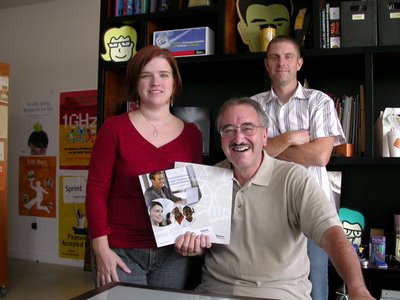 This morning’s HEART OF THE CITY cartoon shows precisely why Mark Tatulli is much loved around this house. Who else would not only remember the Pythons’ “Ministry of Silly Walks” sketch, but put it into a cartoon strip? Thanks, Mark, for keeping pop culture just a little wittier than Madonna’s next adoption and Paris Hilton.
This morning’s HEART OF THE CITY cartoon shows precisely why Mark Tatulli is much loved around this house. Who else would not only remember the Pythons’ “Ministry of Silly Walks” sketch, but put it into a cartoon strip? Thanks, Mark, for keeping pop culture just a little wittier than Madonna’s next adoption and Paris Hilton.Sunday, October 29, 2006
Silly Walks
 This morning’s HEART OF THE CITY cartoon shows precisely why Mark Tatulli is much loved around this house. Who else would not only remember the Pythons’ “Ministry of Silly Walks” sketch, but put it into a cartoon strip? Thanks, Mark, for keeping pop culture just a little wittier than Madonna’s next adoption and Paris Hilton.
This morning’s HEART OF THE CITY cartoon shows precisely why Mark Tatulli is much loved around this house. Who else would not only remember the Pythons’ “Ministry of Silly Walks” sketch, but put it into a cartoon strip? Thanks, Mark, for keeping pop culture just a little wittier than Madonna’s next adoption and Paris Hilton.Thursday, October 26, 2006
Mother’s Day
Did you hear the one about the new Marketing Director at an oilfield equipment company who, after interviewing several design firms to select a “marketing partner” for the company, hired his mother for the work instead?
Top of the world, Ma!
Top of the world, Ma!
Tuesday, October 24, 2006
Healthcare Videos

 New videos for St. Michael’s Center for Special Surgery are in the can and appearing in doctors’ and patients’ hands throughout Houston. I was “above the line” – the copywriter for Locke Bryan Productions on these projects.
New videos for St. Michael’s Center for Special Surgery are in the can and appearing in doctors’ and patients’ hands throughout Houston. I was “above the line” – the copywriter for Locke Bryan Productions on these projects.The establishing shot for each video (the night shot of the façade of the Center) is the tone-setter. Dr. Michael Brown has created an outstanding facility for specialized day surgery.
St. Michael’s is quite a combination: a surgical center than feels more like a luxury retreat than a hospital, advanced medical and surgical equipment, and one of the most dedicated group of healthcare professionals I’ve every worked with. In fact, both videos rely heavily on interviews with the nurses, OR technicians and support staffers. Even though you’re looking at two “facility” stills from the videos (above), about half of each video is filled with interviews with the St. Michael’s team.
Without prompting, every one of the staffers we interviewed for the videos emphasized that the patient always comes first. Edgar Duran, one of St. Michael’s surgical scrub technicians, said, “The patient is number one here…is of paramount importance. We want to make sure that the patient’s stay here is pleasant.”
Working with Stryker surgical lighting systems and C-arm fluoroscopy was worthwhile; working with the St. Michael’s people was better…and it shows in Locke’s close-ups. These are the money shots.
(I’m sprinkling movie-writing terms throughout – it’s an affectation, true, but fun! The St. Michael’s videos have strategies and objectives, just like other marketing communication projects: we left the character arcs and plot reversals for Hollywood.)
More than 15 years ago, Health Industry Today forecast that interest in freestanding surgical centers was expected to keep going up during the “next decade” because the number of both centers and specialized procedures was continue to grow. Now it’s 2006. The pace has accelerated, Have you seen the new specialty hospital or clinic that’s going up in your neighborhood?
Surgical centers offer additional ways for doctors to deliver healthcare to their patients, not stealing market share from major hospitals but supplementing the healthcare system with extra efficiencies and amenities – especially when a center like St. Michael’s raises the bar in terms of quality patient care and optimized efficiencies.
And when today’s healthcare system problems are genuinely offset by the people who deliver the healthcare, then making video’s for St. Michael’s has been an exercise in beneficial communications.
Thanks to Dr. Brown, Crystal Rideau and the staff of St. Michael’s, and to Locke Bryan and his team, too. I enjoyed adding two more examples to my healthcare portfolio.
“Music up. Fade to black.”
Coming soon: “Creating New Healthcare Marketing Opportunities by Leveraging Technology Innovations,” the upcoming AMA Healthcare SIG seminar. Opening Thursday, November 16th. Sign up at www.regonline.com/110834 today.
Saturday, October 21, 2006
Carol Radsprecher
 I have added the painting above to our collection – by adoption. It’s been a learning experience and a joyful one.
I have added the painting above to our collection – by adoption. It’s been a learning experience and a joyful one.First, I better tell you about FAAN – the Fine Arts Adoption Network. It has been initiated by artist Adam Simon with a mission to connect artists and potential collectors.
Adoption means acquiring an artwork without purchasing it, through an arrangement between the artist and collector. FAAN’s goal is to help increase and diversify the population of art owners and to offer artists new means for engaging their audience. The copyright is owned by the artist, of course. The collector owns the painting itself.
First, there’s the “arrangement.” FAAN asked me to initiate an e-mail conversation with the artist whose work I selected. I wrote an introductory note to Carol Radsprecher about her painting, “Carcinaquaria with Toys.” She e-mailed back – from the Brooklyn Public Library. We’ve traded e-mails a dozen times, getting used to one another, exploring each other’s quirks.
She wrote me, “I am the most citified human on earth, at least as regards New York City. I was born and remain in Brooklyn, as my bio said; Brooklyn Heights, actually, which is very much Manhattan in terms of the inhabitants.”
Carol got her MFA in painting from Hunter College, CUNY, in 1988, after receiving a BFA in painting from Hunter in 1985. She’s painted for many years and had solo exhibitions in the Pierro Gallery at South Orange (New Jersey); the Garrison Art Center (Garrison, NY); Get Real Art Gallery (New York City); and Thompson Park Art Exhibition Series (Lyncroft, NJ). You can see her list of shows and juried exhibitions here and more of her pieces here.
Then I got the word from FAAN: Congratulations on adopting “Carcinaquaria with Toys” by Carol Radsprecher!
“Carcinaquaria” is part of an on-going series of oil paintings on canvas (like her “White Floaters” on this page). Sexuality is explored, as well as playing around with line. Carol’s statement on NeoImages explains the general background of the series:
Everything—everything—on earth has a shape, whether we can see it naturally or with the help of microscopes and other mechanical means. This idea that nothing physical can exist without having taken a shape (usually comprised of smaller shapes) is the impetus behind many of these paintings. I begin each painting with a series of repetitive lines, aiming for a complex field of linear and color-formed shapes.
“…playing around” is a key phrase – and it has taken me a couple of days to get used to having a genuine Radsprecher painting here in Houston.
If somebody (maybe Bob Fusillo) has already said that art teaches you about yourself, then I apologize to him or her. But continually looking at "Carcinaquaria" for the past three days has informed me considerably.
I discovered that I am used to, and gravitate toward, the dramatic in modern painting. Carol’s painting has less drama than I expected…but much more sly humor in it and that makes me smile.
Barbara insists the light comes from the lower left (if there is indeed an imaginary light casting shadows); I believe it comes from upper right. And maybe there is no light at all. The title helps: does it have something to do with smoking? I haven’t confirmed this yet with Carol.
Thanks to FAAN for facilitating and Carol for letting me adopt her painting and bring it south, because I'm increasingly seduced by its technique, its charm and its crafty ways.
“Carcinaquaria with Toys” by Carol B Radsprecher, oil on canvas, 20 x 20 inches. Now in the Collection of Richard Laurence Baron & Barbara Nytes-Baron.
Wednesday, October 18, 2006
Brand Murder?
 There’s mudslinging. Character assassination. Sex. It’s not even about politics. It’s what’s happening to brands these days.
There’s mudslinging. Character assassination. Sex. It’s not even about politics. It’s what’s happening to brands these days.There has been a lot of chat lately about giving your customers some control over your brand. The “experts” have been saying that the youngest members of a company’s customer base aren’t likely to be persuaded by traditional interactions with a company and its products. You’re supposed to be experimenting, using new media, accepting new attitudes. Aren’t you?
An article by Rance Crain called “How Do You Get Control Back If You Cede Brands to Consumers?” was just published in the October 15th issue of Ad Age. Part of what Crain wrote:
Here's a question: With all this talk about consumers taking control of brands, how do you get control back again if you decide to change direction? Or once you open the gates, is your brand's destiny out of your hands forever?
Right now, Burger King’s bad-boy promotions are built around its creepy King character and aimed at male teenagers. But that doesn’t give the restaurant chain much to build on if it decides to play nice or to expand its pitch to other target groups….Russ Klein of Burger King said turning your brand over to the consumer enables “social connectivity” as a means of empowerment.I couldn’t help think but what a dangerous game he’s playing.
The current BK strategy is for it to develop “social currency,” and Mr. Klein said to achieve this aim, “it's more important to be provocative than pleasant.”
Crain’s ultimate point is that Burger King is losing control of its brand, rather than providing that social connectivity. If you don’t believe that, go here (or Google “Burger King Commercial” and select “Banned Burger King Commercial” – but be careful, this one is more than a little disturbing).
You can watch the real Burger King commercials here – something for everyone, from chickens with attitude to the “Stackers Union” spot, or (in the BK® Table Guests section) conversations with models from Maxxim magazine.
It’s like Burger King Meets Las Vegas – you know, the place where what happens there stays there. Except for Burger King, it doesn’t: the results are all over the web, quite aside from your TV sets.
Michael Fielding, writing in the American Marketing Association’s Marketing News this month, says that brand owners are already…uh…screwed. “Companies no longer control their brands: Joe Chemo, Camel’s sickly camel stricken with lung cancer? Burger King’s mascot in an salacious visit to a couple’s bedroom? (See above.) An ad hoc commercial for Chevy Tahoe saying ‘global warming is here’?”
Don’t think, colleagues and clients, that the problem is confined to consumer brands. There’re many companies that have been hammered by what Marketing News calls “doppelgangers” – the websites and blogs that have been created by citizens with intentions either parodic or just plain nasty.
Not only media commentators, but bloggers too, have analyzed commercials from firms like Halliburton and BP (for example). These commentators reach a lot of consumers…maybe even your customers.
The current thinking: don’t fight back..mostly. Susan Fournier, quoted in the Marketing News article (page 15), says that fighting the doppelganger is against the entire new marketing paradigm; that co-creation is the key to creating brands.
I think you should find ways to fight. The Internet, blogs, texting – the new media offer ways for disgruntled people to strike at your brand and spread the word…often so fast that you may not even be aware of the negative imagery. You cannot control it, no matter how angry you and your senior management get. But you can moderate the negatives. Tell your side of the story. Interact with your markets in a positive way.
Do not, as Honeywell did years ago in response to a negative article in Fortune, pull all your advertising from the offending magazine(s) and go sit in your “quiet place.”
Do not let other people dictate how your brand is perceived. Fight the good fight.
Thanks to Rob Schoenbeck for kicking this one off. Photo taken from home.blarg.net/.../blosxom.cgi/2005/Apr/ with apologies. Google/Image for “Burger King” and you’ll see quite a few more.
Saturday, October 14, 2006
Minnesota Blues

Won’t you come home, Barb Baron?
Won’t you come home?
I’ve moaned the whole month through.
I’ve done the laundry, honey,
I’ve paid the bills.
I’ve plain been missing you.
You remember that sunny morning,
I dropped you off, to fly away and see your mom?
I know you love snow – I can’t take no mo’.
Barb Nytes, won’t you please come home?
Won’t you come home, Barb Baron?
Won’t you come home?
New Prague’s a long, long way.
You’ve done mom’s packing, honey,
So she can move.
What more can Rosie say?
You’ve had your snowfall, baby,
You’ve had your cold, and now that your sinuses are clear,
Please come back to me – it’s not so winter-y,
But Barbara, won’t you please come home…
That’s back to Houston, sweetheart…
Dear Barbara, won’t you please come home!
Louis Armstrong is turning in his grave. Atmosphere-establishing photo courtesy of www.homes.com
Friday, October 13, 2006
USS Clinton
 By this time, you probably already know that the US Navy has introduced a new class of aircraft carrier into the fleet. The USS William Jefferson Clinton (CVS 1), above, set sail from its home port of Vancouver, British Columbia in June, 2006.
By this time, you probably already know that the US Navy has introduced a new class of aircraft carrier into the fleet. The USS William Jefferson Clinton (CVS 1), above, set sail from its home port of Vancouver, British Columbia in June, 2006.According to many reports on the Web, the ship is the first of its kind in the Navy and is a standing legacy to President Bill Clinton “for his foresight in military budget cuts” and his conduct while president. The US Naval Sea Systems Command (NAVSEA) emphatically denied that the new carrier is part of the Navy's “21st Century Aircraft Carrier Project.”
While this is not the first major US warship named after a president - e.g., USS Ronald Reagan (CVN 76) - it is the first carrier in recent memory that is constructed entirely from recycled aluminum. Its cruising speed (unclassified) is five knots. Its airwing is comprised of one (unarmed) F-14 Tomcat or one (unarmed) F/A-18 Hornet aircraft. Although they cannot be launched or recovered on the 100-foot flight deck, former National Security Advisor Sandy Berger says they “form a very menacing presence. Really.”
It does share the distinction (with USS Reagan and USS Jimmy Carter - see below) of being named after a person who was alive at the time of its christening. It was built in just 14 months and launched to pre-empt the introduction of USS George H W Bush (CVN 77), the Navy’s newest Nimitz-class nuclear-powered carrier, into the fleet. The Democratic National Committee declined to comment on Clinton’s hurried construction.
As a standing order, no firearms allowed on board. The 20-person crew is fully diversified and includes members of all races, creeds, sex and sexual orientation. An unidentified Naval spokesman denied there was an additional order that “if the boat is rockin’, don't come knockin’.”
The crew, like the much larger complement embarked on USS Jimmy Carter (SSN 23), is specially trained to avoid conflicts and appease any and all enemies of the United States at all costs.
USS Clinton will boast the ability to steer a course straight down the middle, but will have a tendency to veer to the left or toward large sums of money. Unlike the much larger Nimitz-class carriers, it will be powered by an unending supply of overconfidence, which perpetually replenishes itself; but may use hamburgers as an alternative fuel. Critics say that maintenance of this class of carrier will be difficult, as items will constantly disappear from the aircraft and wardroom furniture will mysteriously vanish.
An onboard Type One DNC Universal Translator can send out messages of apology in any language to anyone who may find America offensive. The number of apologies is limitless; though some may sound hollow and disingenuous, the Navy advises all apologies will sound very sincere.
The ship’s mission is not defined as a unit of national defense under the Navy’s “Forward…from the Sea” strategic deployment vision. Instead, in times of conflict, USS Clinton has orders to seek refuge in Canada. The ship will be initially deployed near the Democratic National Party headquarters on Capitol Street in Washington, DC, for photo opportunities; and can be used extensively for social experimentation.
The official launching included speeches by former presidents, the US Marine Corp Band and a wet T-shirt contest.
Old news revised. Thanks and a tip of the Hatlo hat to www.blustarchronicles.com and Paul Hoven. Writers for Conan O'Brien assisted in compiling this article.
Friday, October 06, 2006
Essential Punctuation
 Dude – where’s my “s?”
Dude – where’s my “s?”In an otherwise interesting billboard on Interstate 10 just west of Studemont, whomever is doing the outdoor for the American Chemistry Council (ACC) has decided to follow a punctuation stylebook of his own.
The possessive form of Texas is supposed to be Texas’s.
The headline on the right should read, “$72 billion of Texas’s economy?”
The beginning of the question is “what’s essential2” on the left-hand side of the board.
It’s part of a new $35 million dollar public education campaign started about this time last year by the ACC, the trade association for the world's leading companies engaged in the business of chemistry. It’s designed to increase awareness of the chemistry industry’s contributions to modern life, from innovations in everyday products to the US economy overall.
The integrated “essential2” campaign uses advertising, public relations, a new website and employee communications. It was created in conjunction with Ogilvy & Mather, Ogilvy Public Relations Worldwide and APCO Worldwide.
I earn part of my living from my work with the chemical industry and have done so for years. Still, it hasn’t escaped criticism: the ACC has been caught doing some not-quite-right things over the years.
Nevertheless, I applaud the campaign effort – particularly the billboard design, which has the potential (in other executions) to drive home strong economic facts about the contributions of the chemical industry.
In this one, though, the copywriter is using some less rigorous style book. Or the art director ran out of room on the board and decided to eliminate the extra “s” in Texas.
My dear old Fowler’s Modern English Usage (Second Edition) states on page 46: “…elsewhere we now usually add the s and the syllable.”
I also offer Garner’s recent Dictionary of Modern American Usage, page 509: “To form a singular possessive, add –‘s to most singular nouns – even those ending in –s and –x (hence witness’s, Vitex’s, Jones’s, Nichols’s.)”
Alright, so it’s the pea under my mattress today. But this is an important campaign for the chemical industry. Why screw up a perfectly nice billboard with incorrect English usage?
Campaign theme is Photograph courtesy of Paul Leigh. Materials © 2006 American Chemistry Council, Inc.
Tuesday, October 03, 2006
Raising Empyrean
 How do you transfer the vision of combining health benefit “products,” customer services and information technology to paper? You distill the convergence into words and graphics – like this new brochure set for Empyrean Benefit Solutions does.
How do you transfer the vision of combining health benefit “products,” customer services and information technology to paper? You distill the convergence into words and graphics – like this new brochure set for Empyrean Benefit Solutions does.Kathy Mackey, Empyrean’s Manager of Marketing Communications, wrote, “Thanks for creating the three-dimensional product, service, and technology idea. It has defined our company.”
Prism Design made it all look even better: a graphic concept capitalized on the overlapping nature of Empyrean’s interlocking implementation strategy. It brings an upscale look to the very crowded health benefits marketplace. At the same time, the design’s colors (corporate but warm) and sympathetic photos promote accessibility, whether you’re a broker, an HR manager or an employee.
Mackey continues, “Thank you and Prism Design for creating a perfect representation of Empyrean Benefit Solutions. The process of creating brochureware is not an easy task. We are delighted with the results. I value your experience, professionalism and dedication to the field.”
I worked tight with Empyrean to frame its vision in a discrete set of words. The company’s insistence that contemporary health benefits cannot be delivered cost-effectively except by information technologies is highlighted in these materials.
There’s no longer any real doubt that interactive health communication, patient-centric portals, online doctors’ visits, personalized disease management and wellness programs, individual education and web-enabled CRM will deliver cost and quality transparency to consumers – US healthcare has grown too complicated and too costly.
The Wall Street Journal is co-sponsoring a global forum about healthcare innovation and technology. The write-up is filled with jargon, like “Navigating the Information Age,” “eHealth and the Consumer Driven Movement” and “Patient Centric Approach.”
 With Empyrean, we avoided the buzzwords. The brochureware has to speak to several audiences, including insurance brokers (now called producers), company and association benefits managers and individual consumers. We distilled the company’s message to simplify the presentation and raise its profile.
With Empyrean, we avoided the buzzwords. The brochureware has to speak to several audiences, including insurance brokers (now called producers), company and association benefits managers and individual consumers. We distilled the company’s message to simplify the presentation and raise its profile.We also avoided a corporate slogan or tag line. It’s difficult enough to drive a new brand in today’s marketplace without extra baggage. I think the company’s name carries the message.
Simple is better than complex.
Bottom photo, standing: Anne Stovall, Designer & Terry Teutsch, Chief Designer, Prism Design, Inc. Seated: moi. Appreciation to the Empyrean Benefit Solutions team for perseverance and good words.
Subscribe to:
Posts (Atom)